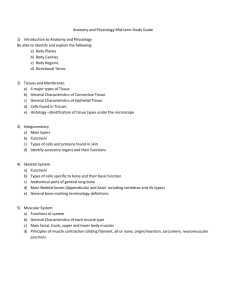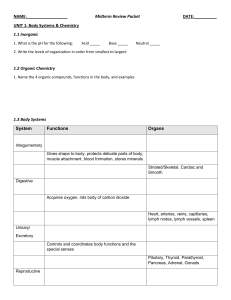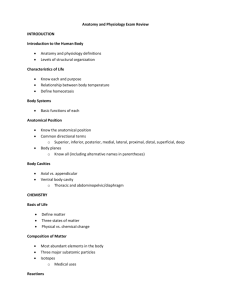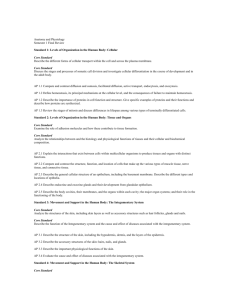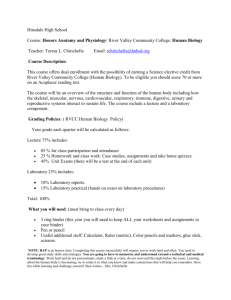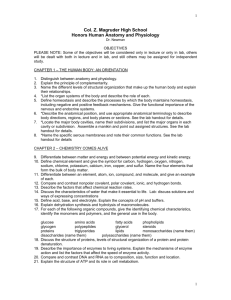COURSE GOALS : BSC 2085
advertisement
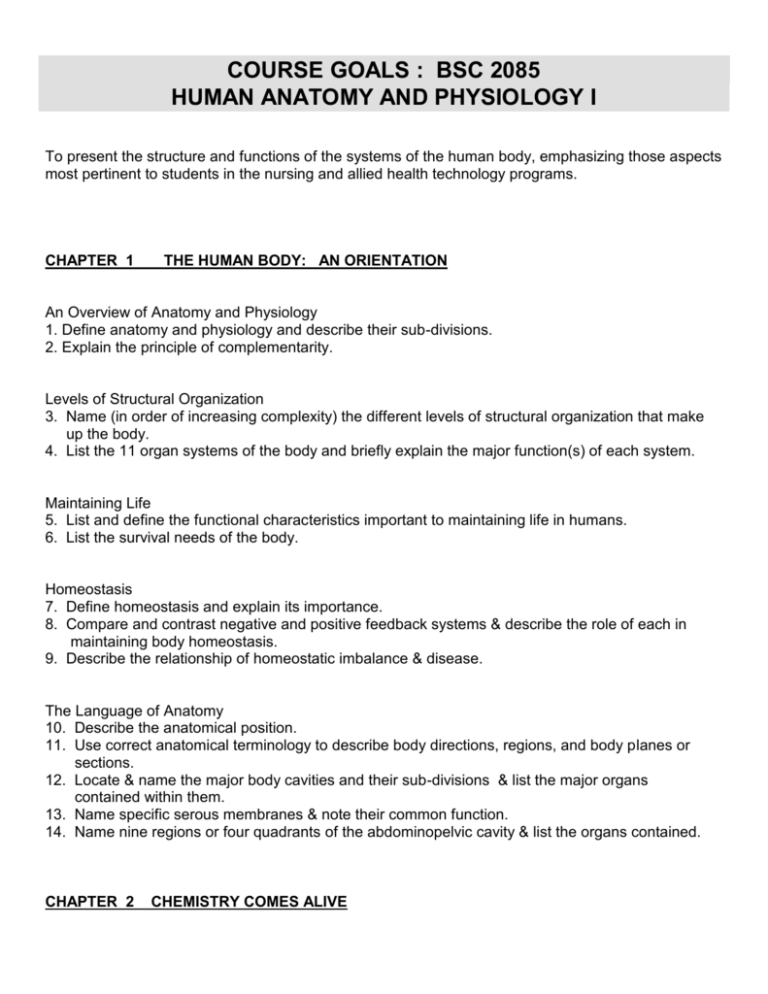
COURSE GOALS : BSC 2085 HUMAN ANATOMY AND PHYSIOLOGY I To present the structure and functions of the systems of the human body, emphasizing those aspects most pertinent to students in the nursing and allied health technology programs. CHAPTER 1 THE HUMAN BODY: AN ORIENTATION An Overview of Anatomy and Physiology 1. Define anatomy and physiology and describe their sub-divisions. 2. Explain the principle of complementarity. Levels of Structural Organization 3. Name (in order of increasing complexity) the different levels of structural organization that make up the body. 4. List the 11 organ systems of the body and briefly explain the major function(s) of each system. Maintaining Life 5. List and define the functional characteristics important to maintaining life in humans. 6. List the survival needs of the body. Homeostasis 7. Define homeostasis and explain its importance. 8. Compare and contrast negative and positive feedback systems & describe the role of each in maintaining body homeostasis. 9. Describe the relationship of homeostatic imbalance & disease. The Language of Anatomy 10. Describe the anatomical position. 11. Use correct anatomical terminology to describe body directions, regions, and body planes or sections. 12. Locate & name the major body cavities and their sub-divisions & list the major organs contained within them. 13. Name specific serous membranes & note their common function. 14. Name nine regions or four quadrants of the abdominopelvic cavity & list the organs contained. CHAPTER 2 CHEMISTRY COMES ALIVE Definition of Concepts: Matter and Energy 1. Differentiate between matter and energy and between potential energy and kinetic energy. 2. Describe the major energy forms. Composition of Matter: Atoms and Elements 3. Define chemical elements. 4. Define atom. List subatomic particles; describe masses, charges & positions in the atom. 5. Define atomic number, atomic mass, atomic weight, isotope. How Matter Is Combined: Molecules and Mixtures 6. Distinguish between a compound & a mixture. Define molecule. 7. Compare solutions, colloids, and suspensions. Chemical Bonds 8. Explain the role of electrons in chemical bonding and in relation to the octet rule. 9. Differentiate between ionic and covalent bonds. 10. Compare and contrast polar and nonpolar compounds. Chemical Reactions 11. Identify three malor types of chemical reactions (synthesis, decomposition and exchange). 12. Explain why chemical reactions in the body are often irreversible. 13. Describe factors that affect chemical reaction rates. Inorganic Compounds 14. Explain the importance of water and salts to body homeostasis. 15. Define acid and base, and explain the concept of pH. Organic Compounds 16. Describe/compare the structures & functions of carbohydrates, lipids, proteins, & nucleic acids. 17. Explain the role of dehydration synthesis and hydrolysis. 18. Compare the functional roles of neutral fats, phospholipids, and steroids in the body 19. Describe the four levels of protein structure. 20. Describe the general mechanism of enzyme activity. 21. Describe the function of molecular chaperones. 22. Compare and contrast DNA and RNA. 23. Explain the role of ATP in cell metabolism. CHAPTER 3 CELLS: THE LIVING UNITS Overview of the Cellular Basis of Life 1. Define cell. 2. List the three major regions of a generalized cell. The Plasma Membrane - Structure 3. Describe the chemical composition of the plasma membrane and relate it to membrane functions. 4. Compare the structure and function of tight junctions, desmosomes, and gap junctions. The Plasma Membrane: Functions 5. Relate the plasma membrane structure to active and passive transport mechanisms. 6. Define membrane potential and explain how the resting membrane potential is maintained. 7. Describe the role of the plasma membrane glycocalyx in cells' interactions with the environment. 8. List several roles of membrane receptors. The Cytoplasm 9. Describe the composition of the cytosol; define inclusions. 10. Discuss the structure and function of mitochondria. 11. Discuss the structure and function of ribosomes, the endoplasmic reticulum, and the Golgi apparatus; note functional interrelationships among these organelles. 12. Compare the functions of lysosomes and peroxisomes. 13. Describe the structure & function of cytoskeletal elements. 14. Describe the roles of centrioles in mitosis. The Nucleus 15. Describe the chemical composition, structure, & function of the nuclear membrane, nucleolus, and chromatin. Cell Growth and Reproduction 16. List the phases of the cell life cycle and describe their events. 17 Describe the process of DNA replication & its importance. 18. Define gene and "genetic code." Explain the function of genes. 19. Name the two phases of protein synthesis and describe the roles of DNA, mRNA, tRNA, rRNA in each phase. Contrast triplets, codons, and anticodons. CHAPTER 4 TISSUE: THE LIVING FABRIC Epithelial Tissue 1. List several structures and functions of epithelial tissue. 2. Classify the different epithelia. 3. Name & describe the various types of epithelia; indicate their chief function(s) and location(s). 4. Define gland. Differentiate between exocrine/endocrine glands & multicellular/unicellular glands. 5. Describe how multicellular exocrine glands are classified structurally and functionally. Connective Tissue 6. Indicate common characteristics of connective tissue, and list and describe its structural elements. 7. Describe types of connective tissue found in the body, & indicate their characteristic functions. Epithelial Membranes 8. Describe the structure and function of cutaneous, mucous, and serous membranes. Nervous Tissue 9. Note the general characteristics of nervous tissue. Muscle Tissue 10. Compare and contrast the structures and body locations of the three types of muscle tissue. Tissue Repair 11. Outline the process of tissue repair involved in normal healing of a superficial wound. Developmental Aspects of Tissues 12. Indicate the embryonic derivation of each tissue class. 13. Briefly describe tissue changes that occur with age. CHAPTER 6 BONES AND SKELETAL TISSUES Skeletal Cartilages 1. Explain the functional properties of each of the three types of cartilage tissue. 2. Locate the major cartilages of the adult skeleton. 3. Explain how cartilage grows. Functions of Bones 4. List and describe five important functions of bones. Classification of Bones 5. Compare & contrast the structure of the four bone classes and provide examples of each class. Bone Structure 6. Describe the gross anatomy of a typical long bone & flat bone. Indicate the locations and functions of red & yellow marrow, articular cartilage, periosteum and endosteum. 7. Indicate the functional importance of bone markings. 8. Describe the histology of compact and spongy bone. 9. Discuss the chemical composition of bone & the relative advantages of its organic & its inorganic components. Bone Development (Osteogenesis) 10. Compare/contrast two types of bone formation: intramembranous & endochondral ossification. 11. Describe the process of long bone growth that occurs at the epiphyseal plates. Bone Homeostasis: Remodeling and Repair 12. Compare locations & functions of osteoblasts, osteocytes, & osteoclasts in bone remodeling. 13. Explain how hormonal controls and physical stress regulate bone remodeling. 14. Describe the steps of fracture repair. Homeostatic Imbalances of Bone 15. Contrast the disorders of bone remodeling seen in osteoporosis& osteomalacia CHAPTER 7 THE SKELETON 1. Name the major parts of the axial & appendicular skeletons and describe their relative functions. Part 1: The Axial Skeleton The Skull 2. Name, describe, and identify the bones of the skull. 3. Describe major functions of cranium & facial skeletons. 4. Define the bony boundaries of the orbits, nasal cavity, and paranasal sinuses. The Vertebral Column 5. Describe the structure of the vertebral column, list its components, and describe its curvatures. 6. Indicate a common function of the spinal curvatures and the intervertebral discs. 7. Discuss structure of vertebrae & describe the features of cervical, thoracic, and lumbar vertebrae. The Bony Thorax 8. Name and describe the bones of the bony thorax. 9. Differentiate true from false ribs. Part 2 : The Appendicular Skeleton The Pectoral (Shoulder) Girdle 10. Identify bones of the pectoral girdle; relate their structure to the function of this girdle. 11. Identify important bone markings on the pectoral girdle. The Upper Limb 12. Identify bones of the upper limb & their important markings. The Pelvic (Hip) Girdle 13. Name the bones contributing to the os coxa & relate the pelvic girdle's strength to its function. 14. Describe differences in the male and female pelves. The Lower Limb 15. Identify bones of the lower limb & their important markings. 16. Name the three supporting arches of the foot. CHAPTER 9 MUSCLES AND MUSCLE TISSUE Overview of Muscle Tissues 1. Compare and contrast the basic types of muscle tissue. 2. List four important functions ofmuscle tissue. Skeletal MuscIe 3. Describe the gross structure of a skeletal muscle with respect to location and names of its connective tissue coverings and attachments. 4. Describe the microscopic structure and functional roles of the myofibrils, sarcop!asmic reticulum, and T tubules of skeletal muscle fibers (cells). 5. Explain the sliding filament mechanism of skeletal muscle contraction 6. Define motor unit and explain how muscle fibers are stimulated to contract. 7. Define muscle twitch and describe the events occurring during its three phases. 8. Explain how smooth graded contractions of a skeletal muscle are produced. 9. Differentiate between isometric and isotonic contractions. 10. Describe three ways in which ATP is regenerated during skeletal muscle contraction. 11. Define oxygen debt and muscle fatigue. List possible causes of muscle fatigue. 12. List & describe factors that influence the force, velocity, & duration of skeletal muscle contraction. 13. Name & describe three types of skeletal muscle fibers. 14. Compare & contrast the effects of aerobic and resistance exercise on skeletal muscles. Smooth Muscle 15. Compare the gross and microscopic anatomy of smooth muscle to that of skeletal muscle. 16. Compare/contrast the contractile mechanisms of skeletal & smooth muscles. 17. Distinguish between single-unit and multiunit smooth muscle structurally and functionally. CHAPTER 11 NERVOUS SYSTEM & NERVOUS TISSUE 1. List the basic functions of the nervous system. Organization of the Nervous System 2. Explain the structural and functional divisions of the nervous system. Histology of Nervous Tissue 3. List the types of supporting cells and cite their functions. 4. Describe the important anatomical regions of a neuron and relate each to a physiological role. 5 Explain the importance of the myelin sheath and describe how it is formed in the central and peripheral nervous systems. 6. Classify neurons structurally and functionally. 7. Differentiate between a nerve and a tract, and between a nucleus and a ganglion. Neurophysiology 8. Define resting membrane potential and describe its electrochemical basis. 9. Compare and contrast graded and action potentials. 10. Explain how action potentials are generated and propagated along neurons. 11. Define absolute and relative refractory periods. 12. Define saltatory conduction and contrast it to conduction along unmyelinated fibers. 13. Define synapse. Distinguish between electrical & chemical synapses structurally and in their mechanisms of information transmission. 14. Distinguish between excitatory and inhibitory post-synaptic potentials. 15. Describe how synaptic events are integrated & modified. 16. Define neurotransmitter and name the classes of them. CHAPTER 15 THE SPECIAL SENSES The Eye and Vision 17. Describe the structure & function of accessory eye structures, eye tunics, lens, & humors 18. Trace the pathway of light through the eye to the retina, and explain how light is focused for distant and close vision. 19. Describe the events involved in the stimulation of photoreceptors by light, and compare and contrast the roles of rods and cones in vision. 20. Note the cause and consequences of astigmatism, cataract, glaucoma, hyperopia, myopia and color blindness. 21. Compare and contrast light and dark adaptation. 22. Trace the visual pathway to the optic cortex & describe the process of visual processing. The Ear: Hearing and Balance 23. Describe the structure and general function of the outer, middle, and inner ears. 24. Describe the sound conduction pathway to the fluids of the inner ear, and follow the auditory pathway from the organ of Corti to the temporal cortex. 25. Explain how one is able to differentiate pitch and loudness and localization of sounds 26. Explain how the balance organs of the semicircular canals and the vestibule function. 27. List possible causes and symptoms of otitis media,deafness, and motion sickness.
